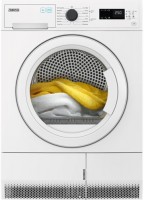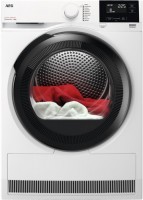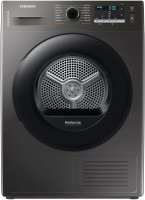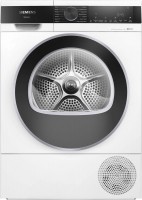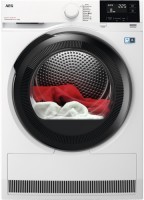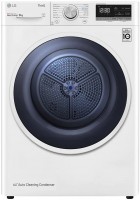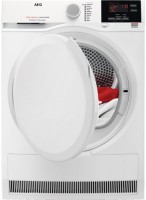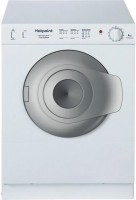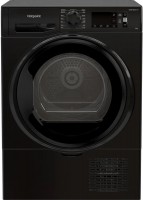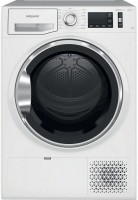Tumble Dryers Bosch
All Tumble Dryers Advanced filters → |
You might be interested in
Articles, reviews, useful tips
All materials
Inverter drive in household appliances: what is it, the pros and cons of inverter control
The inverter provides more efficient, economical and quiet operation of household appliances

TOP devices for a home with pets
Household appliances that will help you get rid of hair, purify and humidify the air and spy on your pet

Seven useful features of modern washing machines that you might not know about
Modern features to look out for when choosing a new washer

What do the symbols on clothing labels mean?
Understanding the meaning of pictograms used for washing, spinning, drying, ironing, bleaching, and dry cleaning clothes

Energy label reform: new gradations of energy efficiency classes for household appliances
Rethinking energy efficiency classes and returning to the historical gradation "from A to G"

How much laundry can be loaded in the washing machine and how to determine the allowable load?
How much laundry can your washing machine “accept” and why you should follow these recommendations
Tumble Dryers: specifications, types
Show all
Drying type
— Condensing (recuperative) The general principle of condensation drying is as follows: heated air is passed through the laundry drum, captures moisture, and then enters the refrigerator, cools down, and excess moisture condenses in a special tank. The advantage of all condensing machines over air vented ones is that they are easy to install. They do not need to be connected to ventilation and can be installed in any room. On the other hand, the user needs to monitor the condensate tank and periodically drain the accumulated water. And such units are somewhat more complicated and more expensive than ventilated ones. However, recuperative dryers are the simplest and most inexpensive among condensing dryers. By the name, the role of a refrigerator in them is played by a recuperator: a heat exchanger that dumps excess heat into the outside air. The heating of the air inside is usually carried out using a heating element. Due to their availability, such machines are very popular, but they have serious drawbacks. Firstly, devices of this type have high electricity consumption. Secondly, the efficiency of their work is relatively low. Moreover, it directly depends on the temperature difference between the air outside and inside the dryer.
— Condensing (heat pump drying). The most advanced and most expensive type of condensing dryer. See above for more information on conde...nsing drying in general. Note that in models of this type, the refrigerator operates due to a heat pump — a compressor that takes excess heat from the condensation chamber and transfers it to the heater. It provides several advantages over traditional recuperative drying. One of the most noticeable is high efficiency and economy: the heat pump allows you to reuse the accumulated thermal energy, and less electricity is spent on its operation than on the constant air heating in recuperative models. In addition, drying is easier and faster, and the work speed is practically independent of outdoor conditions. And such a machine almost does not produce excess heat. The disadvantages of models with a heat pump are traditional — complexity and high cost.
— Air vented. A kind of drying in which excess moisture is blown out of the machine into the outdoor space. Compared to condensing drying, this option allows you to create simpler, cheaper and more compact units. And such models are somewhat easier to use because they do not require monitoring the water level in the condensate tank. On the other hand, installing a ventilated machine is noticeably more difficult. So, in the room where the unit is located, there must be a powerful ventilation system, otherwise, there will always be high humidity and temperature. Such a microclimate is not only harmful to people and furniture but also significantly worsens drying efficiency. If it is impossible to organize general ventilation for the room for one reason or another, one will have to make a separate air duct to remove steam from the dryer. As a result, this type of drying is considered inconvenient and extremely rare.
— Condensing (heat pump drying). The most advanced and most expensive type of condensing dryer. See above for more information on conde...nsing drying in general. Note that in models of this type, the refrigerator operates due to a heat pump — a compressor that takes excess heat from the condensation chamber and transfers it to the heater. It provides several advantages over traditional recuperative drying. One of the most noticeable is high efficiency and economy: the heat pump allows you to reuse the accumulated thermal energy, and less electricity is spent on its operation than on the constant air heating in recuperative models. In addition, drying is easier and faster, and the work speed is practically independent of outdoor conditions. And such a machine almost does not produce excess heat. The disadvantages of models with a heat pump are traditional — complexity and high cost.
— Air vented. A kind of drying in which excess moisture is blown out of the machine into the outdoor space. Compared to condensing drying, this option allows you to create simpler, cheaper and more compact units. And such models are somewhat easier to use because they do not require monitoring the water level in the condensate tank. On the other hand, installing a ventilated machine is noticeably more difficult. So, in the room where the unit is located, there must be a powerful ventilation system, otherwise, there will always be high humidity and temperature. Such a microclimate is not only harmful to people and furniture but also significantly worsens drying efficiency. If it is impossible to organize general ventilation for the room for one reason or another, one will have to make a separate air duct to remove steam from the dryer. As a result, this type of drying is considered inconvenient and extremely rare.
Capacity
The maximum amount of laundry that can be loaded into the dryer; in other words, the largest weight of laundry that the machine can efficiently process in one cycle.
Capacity is usually indicated by the weight of the dry laundry. Thanks to this, when preparing the laundry for washing, you can immediately assess whether it will fit in the dryer at a time or, on the contrary, you can get by with a small drying. However, even the most modest modern dryers (and even slim ones up to 50 cm) in most cases hold 7 kg — this is comparable to loading the drum of a medium-capacity washing machine. And in the most capacious models, this figure can reach 10 – 11 kg. It is quite enough for domestic and even professional use (for example, in laundromats or laundries of hotels, etc.). However, the typical figures are drying for 8 kg and models for 9 kg of laundry. Bigger capacity is relevant for industrial equipment and is not found in consumer-level models.
Also, when choosing, note that in the specs the maximum capacity is usually indicated for linen made of cotton fabric. For other, more voluminous materials, the capacity can be noticeably less — for example, the weight limit for wool products is usually 4-5 times less than for cotton.
Capacity is usually indicated by the weight of the dry laundry. Thanks to this, when preparing the laundry for washing, you can immediately assess whether it will fit in the dryer at a time or, on the contrary, you can get by with a small drying. However, even the most modest modern dryers (and even slim ones up to 50 cm) in most cases hold 7 kg — this is comparable to loading the drum of a medium-capacity washing machine. And in the most capacious models, this figure can reach 10 – 11 kg. It is quite enough for domestic and even professional use (for example, in laundromats or laundries of hotels, etc.). However, the typical figures are drying for 8 kg and models for 9 kg of laundry. Bigger capacity is relevant for industrial equipment and is not found in consumer-level models.
Also, when choosing, note that in the specs the maximum capacity is usually indicated for linen made of cotton fabric. For other, more voluminous materials, the capacity can be noticeably less — for example, the weight limit for wool products is usually 4-5 times less than for cotton.
Drum volume
The internal volume of the dryer drum.
A larger drum can accommodate more laundry, but there is no rigid dependence here: models with the same volume may differ in maximum load. It is because to process a large mass of laundry, one need not only a capacious drum but also an engine of appropriate power. At the same time, in a larger drum, the same mass of laundry will dry more efficiently than in a small one, because laundry will be more freely distributed over the drum, crumpled less, and warm air will better penetrate the folds of the fabric. As a result, for the same drum volume, a model with a smaller load will be more efficient and performant than a model with a larger load. On the other hand, a volumetric drum takes up more space and the dimensions of the dryer are largely determined by the dimensions of the drum.
A larger drum can accommodate more laundry, but there is no rigid dependence here: models with the same volume may differ in maximum load. It is because to process a large mass of laundry, one need not only a capacious drum but also an engine of appropriate power. At the same time, in a larger drum, the same mass of laundry will dry more efficiently than in a small one, because laundry will be more freely distributed over the drum, crumpled less, and warm air will better penetrate the folds of the fabric. As a result, for the same drum volume, a model with a smaller load will be more efficient and performant than a model with a larger load. On the other hand, a volumetric drum takes up more space and the dimensions of the dryer are largely determined by the dimensions of the drum.
Inverter motor
The presence of an inverter motor in the design of the dryer.
An inverter motor is a motor whose power and speed can be smoothly and accurately adjusted — in contrast to a conventional electric motor, in which adjustments are made in steps. However, the main advantages of machines with this function are low energy consumption and noise level. In addition, inverter motors have relatively few moving parts, which has a positive effect on reliability and durability. Their disadvantages are high price and difficulty in repair.
An inverter motor is a motor whose power and speed can be smoothly and accurately adjusted — in contrast to a conventional electric motor, in which adjustments are made in steps. However, the main advantages of machines with this function are low energy consumption and noise level. In addition, inverter motors have relatively few moving parts, which has a positive effect on reliability and durability. Their disadvantages are high price and difficulty in repair.
Number of drying programmes
The number of preset drying programmes. Such programmes are often optimized for a specific type of fabric: linen, silk, synthetics, etc. The more drying programmes, the more versatile and easier the dryer is to use. However, a specific set of modes in different models may be different, and even a large variety of programmes does not guarantee that one of them will be suitable. So before buying, it is advisable to specify not only the quantity but the list of claimed programmes.
Custom programme
Itis an ability to set the machine custom programme of work. In such a programme, the user can specify the operating parameters (duration, temperature, rotation intensity, etc.) at his discretion; this gives additional options for managing the unit. The custom programme can be useful in non-standard situations, when none of the predefined operating modes is suitable.
Note that the set of parameters that are set when creating your programme may be different in different models; these details need to be clarified separately.
Note that the set of parameters that are set when creating your programme may be different in different models; these details need to be clarified separately.
Anti-crease function
This function of the dryer prevents the formation of the crease on the laundry as much as possible, which facilitates subsequent ironing. Of course, anti-crease function does not give a full guarantee against creasing, but it noticeably makes life easier for the user. Especially when working with fabrics like linen or in cases where the things themselves are not particularly wrinkled but can crumple with inaccurate drying.
Moisture sensor
Ability to choose the residual moisture content of the linen to be dried - from completely dry, which can be immediately put in the closet, to slightly dry, which is optimal for ironing. With laundry moisture control, the user needs to select the desired residual moisture - the dryer will automatically control the condition of the laundry and stop drying at the right time.
Delay start timer
This function allows you to pre-load laundry into the dryer and set the start time so that drying ends at the most convenient time, for example, when you will be at home and can immediately unload the laundry to avoid unnecessary creases on it. The range and accuracy of the timer adjustment can be different, but even in the simplest models, time can be set within a few hours in increments of 10-15 minutes — this is quite enough for most cases.
Steam drying
The presence of a drying programme with steam in the dryer.
In this mode, the laundry in the drum is treated with hot steam. Note that this procedure is not suitable for drying as such; its purpose is rather to refresh and moisturize the fabric. For example, steam drying can be used as an alternative to washing when clean unwashed clothing has absorbed an unpleasant odour. It can be used to moisten overdried laundry for subsequent ironing.
In this mode, the laundry in the drum is treated with hot steam. Note that this procedure is not suitable for drying as such; its purpose is rather to refresh and moisturize the fabric. For example, steam drying can be used as an alternative to washing when clean unwashed clothing has absorbed an unpleasant odour. It can be used to moisten overdried laundry for subsequent ironing.
Quick dry
Quick dry programme that dries in a relatively short time. It saves time, but the laundry wears out more than during normal drying and is not suitable for delicate types of fabric.
Refresh cycle
A programme designed to remove odours from clothes, such as tobacco smoke, or an unpleasant odour that appears after a long period of storage. The refresh programme is useful if the clothes are clean, but the smell still needs to be eliminated — refreshing in the dryer takes less time and effort than quick washing and then drying (even if using the same dryer). This function is especially relevant for drying cabinets.
Drying basket
The presence of a drying basket allows you to carefully place woollen items, as well as shoes, which contributes to delicate drying and the laundry does not “fly” around the drum like in washing machines.
Drum lighting
Lighting system for the internal volume of the device. It usually turns on automatically when the dryer door is opened - thus reducing the likelihood that some items (especially small and dark ones) will be forgotten in the drum.
Self-cleaning heat exchanger
System for automatic cleaning of the heat exchanger from fibres and all kinds of deposits that prevent easy air circulation. The self-cleaning function is performed during each drying cycle. It extends the life span of the heat exchanger and ensures consistently low energy consumption over the life span of the dryer.
Self-cleaning door filter
Rinsing the door filter on board the dryer with water after each drying cycle. The self-cleaning door filter eliminates the need to manually clean the filter by removing it from the dryer.
Drain into sewer
This option allows you to automate the process of draining the condensate collection tank (respectively, it is relevant only for dryers with a condensation principle of operation). At the end of the drying process, the condensate accumulated in the tank is automatically drained into the sewer. To do this, a pump and a hose are provided in a dryer with a drain into the sewer. The function of draining into the sewer allows you to significantly simplify the operation of the dryer, while in models without this option, the user must drain the condensate tank manually. Of course, manual emptying does not require much effort because the average condensate collection tank has a volume of about 5 litres, but still not very convenient.
Condensate tank indicator
It is an indicator signalling the filling of the tank with condensate and the need to empty it. It is used exclusively in models with a condensing type of drying (see above). The specific device and functionality of the indicator may be different: in some models, it only warns of a critical liquid level. In others, it can display the exact amount of condensate collected. However, this feature greatly simplifies the monitoring of the operation of the dryer and reduces the risk of flood and other troubles that can lead to an overflow of the tank.
Condensate tank volume
Only condenser dryers have such a tank (see "Drying type"). The larger the tank, the less often you have to get rid of the accumulated liquid. At the same time, in most models, the volume of the condensate tank is standard — about 5 – 6 litres: this is considered the best compromise between capacity and dimensions.
Drying class
Drying class describes the overall drying efficiency that the machine provides. It is denoted by a Latin letter, where A is the best efficiency, and further in decreasing order ( drying class B is inferior to class A, but exceeds class C). Naturally, higher efficiency machines cost more (ceteris paribus).
Energy class
The energy consumption class shows not the actual energy consumption but the efficiency of the dryer. In other words, what part of the electricity consumed goes directly to useful work. For dryers, this parameter is especially important because such devices have high electricity consumption. As a result, models with the same capabilities but different energy efficiency classes differ markedly in terms of operating costs (in terms of electricity bills). However, more economical units themselves are more expensive. nevertheless, this difference quickly pays off.
Initially, classes were marked in Latin letters from A(the highest class) and further alphabetically. In the course of technology development, more economical levels of consumption than the original class A appeared — they are labelled as A+, A++, A+++, etc. Actually, the highest efficiency class in modern dryers is exactly A +++ ; level A — A+ can be called good, B — average, C — acceptable.
Initially, classes were marked in Latin letters from A(the highest class) and further alphabetically. In the course of technology development, more economical levels of consumption than the original class A appeared — they are labelled as A+, A++, A+++, etc. Actually, the highest efficiency class in modern dryers is exactly A +++ ; level A — A+ can be called good, B — average, C — acceptable.
Noise level
The noise level generated by the dryer during operation. Usually, the specs indicate the maximum volume of the device, in the noisiest mode — when other programmes are running, this figure may be lower. We note that the noise level also depends on the features of the installation: for example, if the machine does not stand firmly on all four legs, vibration from drum rotation can create additional noise. And the tiled walls amplify the sound by creating an echo. Nevertheless, it is best to evaluate the device precisely by the noise level stated in the specifications. And here it is worth bearing in mind that the decibel used to denote loudness is a non-linear value, and it is best to evaluate the actual loudness of the unit using comparative tables. Here is the simplest such table for the volume range in which modern dryers operate:
65 dB — a person's voice in raised tones at a distance of 1 m;
70 dB — a loud conversation of several people at the same distance;
75 dB — loud laughter at a distance of 1 m;
80 dB — motorcycle engine, medium power vacuum cleaner.
The quieter the machine is, the more comfortable it will be to use and the better it will be suitable for a specific environment (for example, if there is a small child in the house or if you plan to run drying at night). At the same time, it is worth considering not only the actual noise level but also the installation location of the device. If the dryer is planned to...be installed in the basement of a private house with thick ceilings and the bedroom is located on the second floor, you can not pay much attention to the noise level: even the loudest unit is unlikely to create inconvenience.
65 dB — a person's voice in raised tones at a distance of 1 m;
70 dB — a loud conversation of several people at the same distance;
75 dB — loud laughter at a distance of 1 m;
80 dB — motorcycle engine, medium power vacuum cleaner.
The quieter the machine is, the more comfortable it will be to use and the better it will be suitable for a specific environment (for example, if there is a small child in the house or if you plan to run drying at night). At the same time, it is worth considering not only the actual noise level but also the installation location of the device. If the dryer is planned to...be installed in the basement of a private house with thick ceilings and the bedroom is located on the second floor, you can not pay much attention to the noise level: even the loudest unit is unlikely to create inconvenience.
Controls
The type of control provided in the machine. Almost all modern dryers are equipped with electronic control, so the design of the control panel mainly depends on this parameter. The options here might be:
— Rotary knob + buttons. The classic option does not lose popularity these days. The rotary knob is usually responsible for selecting the programme and the buttons for controlling additional functions and settings. Such control panels are simple, inexpensive and, at the same time, quite functional. Therefore they are found in all categories of dryers — from low-cost to top.
— Rotary knob + touch controls. The combination of a rotary knob responsible for selecting the main programme and a set of touch controls that control additional parameters. Compared to the buttons described above, the touch panels have a more stylish and technological appearance; moreover, due to the absence of protruding parts, such a panel almost does not accumulate dirt and is easy to clean. At the same time, these features are generally not fundamental, while the touch controls are somewhat more complicated and expensive than buttons. Therefore, this option is found mainly among dryers of the middle and top classes.
— Touch controls. This design, on the one hand, gives the device the most accurate and advanced appearance; on the other hand, the control is not as cle...ar and intuitive as with a handle. Therefore, in its pure form, touch controls are extremely rare — only in high-end dryers.
— Rotary knob + buttons. The classic option does not lose popularity these days. The rotary knob is usually responsible for selecting the programme and the buttons for controlling additional functions and settings. Such control panels are simple, inexpensive and, at the same time, quite functional. Therefore they are found in all categories of dryers — from low-cost to top.
— Rotary knob + touch controls. The combination of a rotary knob responsible for selecting the main programme and a set of touch controls that control additional parameters. Compared to the buttons described above, the touch panels have a more stylish and technological appearance; moreover, due to the absence of protruding parts, such a panel almost does not accumulate dirt and is easy to clean. At the same time, these features are generally not fundamental, while the touch controls are somewhat more complicated and expensive than buttons. Therefore, this option is found mainly among dryers of the middle and top classes.
— Touch controls. This design, on the one hand, gives the device the most accurate and advanced appearance; on the other hand, the control is not as cle...ar and intuitive as with a handle. Therefore, in its pure form, touch controls are extremely rare — only in high-end dryers.
Control via smartphone
The ability to control the dryer via a smartphone or other similar gadget — for example, a tablet — with a special application installed on it. Wi-Fi or Bluetooth is used to connect the gadget, which gives a range of at least several metres. However, the main convenience lies not so much in the remote control itself but in the fact that the application is often more convenient, visual and understandable than the dryer's control panel.
Control via Internet
It is the ability to control the dryer via the Internet. For example, via a special application on a smartphone or a browser on a PC.
The main advantage of such control is that it can be done from almost anywhere in the world where there is an Internet connection. In addition, this function allows not only to give commands to the unit but also to monitor its condition: for example, the machine can report the remaining operating time, warn the user about various failures, etc. The specific capabilities and technical features of control via the Internet should be clarified separately. We only note that the connection of the machine to the network is usually carried out via Wi-Fi.
The main advantage of such control is that it can be done from almost anywhere in the world where there is an Internet connection. In addition, this function allows not only to give commands to the unit but also to monitor its condition: for example, the machine can report the remaining operating time, warn the user about various failures, etc. The specific capabilities and technical features of control via the Internet should be clarified separately. We only note that the connection of the machine to the network is usually carried out via Wi-Fi.
Display
The type of display provided in the design of the dryer.
The screen located on the control panel provides additional convenience: it can display various information about the operation of the machine. In this case, the specific functionality of the screen depends on its type. So, in the vast majority of cases, the simplest LED displays are used. They can only display numbers and some special characters, but even this is usually sufficient. In some models, TFT display can be installed — similar to those used in smartphones. Such a display can display not only textual information but also various graphics, and sometimes it is even made touch-sensitive. However, it makes sense to use such screens only in high-end devices with an abundance of functions.
The screen located on the control panel provides additional convenience: it can display various information about the operation of the machine. In this case, the specific functionality of the screen depends on its type. So, in the vast majority of cases, the simplest LED displays are used. They can only display numbers and some special characters, but even this is usually sufficient. In some models, TFT display can be installed — similar to those used in smartphones. Such a display can display not only textual information but also various graphics, and sometimes it is even made touch-sensitive. However, it makes sense to use such screens only in high-end devices with an abundance of functions.
Child lock
It is a dryer control blocking system. Thus, the child will not be able to change the running programme of the machine, stop the programme prematurely, etc. Child lock is usually disabled in a way that is not accessible to a child, but does not cause difficulties for an adult. For example, by simultaneously pressing two keys.
Surge protection
It is a system that protects the dryer from power surges. Usually, such protection includes the simplest voltage stabilizer capable of coping with relatively low-power short-term drops. If the capabilities of the stabilizer are not enough, the system completely disconnects the dryer from the mains and resumes power only when the voltage parameters return to normal. Usually, the current programme is remembered and, after switching on, continues from the same point where it stopped.
Loading hatch diameter
The diameter of the loading hatch of the dryer. For models with a rectangular hatch (see “Door shape”), in this case, one of the dimensions is indicated — either width or height.
On the one hand, the larger the opening, the more convenient it is to load laundry into the machine, especially large items like bedding. On the other hand, a large hatch requires the appropriate space in front of the device — otherwise, it simply cannot be opened normally. With round openings, everything is quite simple: there should be a place in front of the drying machine corresponding to the diameter of the hatch, plus at least 3-5 centimetres in reserve. If the door is rectangular, this point is not so obvious — manufacturers can indicate the height of the opening, not the width. In such cases, it should be assumed that the door usually occupies almost the entire width of the front of the dryer. Accordingly, normal opening requires free space no less than the total width of the unit.
On the one hand, the larger the opening, the more convenient it is to load laundry into the machine, especially large items like bedding. On the other hand, a large hatch requires the appropriate space in front of the device — otherwise, it simply cannot be opened normally. With round openings, everything is quite simple: there should be a place in front of the drying machine corresponding to the diameter of the hatch, plus at least 3-5 centimetres in reserve. If the door is rectangular, this point is not so obvious — manufacturers can indicate the height of the opening, not the width. In such cases, it should be assumed that the door usually occupies almost the entire width of the front of the dryer. Accordingly, normal opening requires free space no less than the total width of the unit.
Door shape
The shape and design of the door used in the dryer.
— Round. The round door is made of opaque material. In general, round openings and covers for them are simpler and cheaper to manufacture than rectangular ones, which is why they are much more common. With similar dimensions, they have a smaller area. However, the round loading hatch is made quite large and does not cause problems if it is necessary to place a large object such as a duvet cover or sheet in the dryer. Opaque doors are as simple and cheap as possible but not very convenient. They do not allow you to see the contents of the machine when the door is closed. And this is important for many users (see below for more details).
— Round with glass. A round-shaped door with an insert made of transparent material — usually plexiglass or other similar plastic (ordinary glass is less reliable and is not used in dryers). The general features of the round door are described above, and the transparent insert allows you to see the contents of the drum without opening the lid — including observing the drying process itself. Such an observation provides more general comfort and reassurance than any practical benefit; however, even these moments are important when using household appliances. In addition, there are quite practical situations in which transparent inserts can come in handy — for example, when you need to make sure that unnecessary things do not get into the drum and it would be inconvenient...to interrupt the programme and open the hatch. Such doors are somewhat more expensive than opaque ones, but the advantages described are often decisive. As a result, this option is the most popular in modern dryers.
— Rectangular. Rectangular opaque door. A door of this shape gives the user more space to load laundry than a round one; theoretically, this can be useful for numerous items, especially large ones. At the same time, this advantage is not decisive, rectangular doors are somewhat more expensive, and an opaque door is also not very convenient, at least from a psychological point of view (and often from a practical one). Because of this, this option is extremely rare.
— Rectangular with glass. Rectangular door with a transparent insert made of plexiglass or other similar material. Doors with glass are somewhat more user-friendly than opaque ones (see "Round with glass" above for more on this), so this option is more common than opaque rectangular doors. However, this form is still more expensive than the round one and is used much less frequently.
— Round. The round door is made of opaque material. In general, round openings and covers for them are simpler and cheaper to manufacture than rectangular ones, which is why they are much more common. With similar dimensions, they have a smaller area. However, the round loading hatch is made quite large and does not cause problems if it is necessary to place a large object such as a duvet cover or sheet in the dryer. Opaque doors are as simple and cheap as possible but not very convenient. They do not allow you to see the contents of the machine when the door is closed. And this is important for many users (see below for more details).
— Round with glass. A round-shaped door with an insert made of transparent material — usually plexiglass or other similar plastic (ordinary glass is less reliable and is not used in dryers). The general features of the round door are described above, and the transparent insert allows you to see the contents of the drum without opening the lid — including observing the drying process itself. Such an observation provides more general comfort and reassurance than any practical benefit; however, even these moments are important when using household appliances. In addition, there are quite practical situations in which transparent inserts can come in handy — for example, when you need to make sure that unnecessary things do not get into the drum and it would be inconvenient...to interrupt the programme and open the hatch. Such doors are somewhat more expensive than opaque ones, but the advantages described are often decisive. As a result, this option is the most popular in modern dryers.
— Rectangular. Rectangular opaque door. A door of this shape gives the user more space to load laundry than a round one; theoretically, this can be useful for numerous items, especially large ones. At the same time, this advantage is not decisive, rectangular doors are somewhat more expensive, and an opaque door is also not very convenient, at least from a psychological point of view (and often from a practical one). Because of this, this option is extremely rare.
— Rectangular with glass. Rectangular door with a transparent insert made of plexiglass or other similar material. Doors with glass are somewhat more user-friendly than opaque ones (see "Round with glass" above for more on this), so this option is more common than opaque rectangular doors. However, this form is still more expensive than the round one and is used much less frequently.
Door opening
The direction in which the door of the dryer opens.
Most users are right-handed, so from this point of view, the best option is leftward opening — the free space for loading and unloading laundry is just under the right hand. However, specifically in dryers, the rightward opening is noticeably more common. It is because such units usually complement washing machines and are most often installed side by side. And in most washers, the door opens just to the left (again, based on convenience for right-handed people). Therefore, it is most convenient to place the dryer on the right and equip it with a hatch that opens to the right — this will allow you to overload the laundry from washer to dryer with minimal effort and time. And vice versa, if the door in the washing machine opens to the right, then it is better to choose a dryer with a leftward opening and install it on the left.
Sometimes both machines are installed as a column — a dryer on top of a washing machine. In such cases, the hatches of both machines should open in one direction — this is more convenient both from the point of view of ergonomics and purely psychologically. Moreover, if the "column” adjoins the wall sideways, then the opening should also occur towards the wall; otherwise, the laundry will have to be loaded and unloaded through the space between the open hatch and the wall, which can be very inconvenient....
Note that in some dryers both opening options are claimed. It usually means that the door has a reversible mount, and the direction of opening can be chosen at your discretion. However, this feature does not hurt to clarify before buying.
Most users are right-handed, so from this point of view, the best option is leftward opening — the free space for loading and unloading laundry is just under the right hand. However, specifically in dryers, the rightward opening is noticeably more common. It is because such units usually complement washing machines and are most often installed side by side. And in most washers, the door opens just to the left (again, based on convenience for right-handed people). Therefore, it is most convenient to place the dryer on the right and equip it with a hatch that opens to the right — this will allow you to overload the laundry from washer to dryer with minimal effort and time. And vice versa, if the door in the washing machine opens to the right, then it is better to choose a dryer with a leftward opening and install it on the left.
Sometimes both machines are installed as a column — a dryer on top of a washing machine. In such cases, the hatches of both machines should open in one direction — this is more convenient both from the point of view of ergonomics and purely psychologically. Moreover, if the "column” adjoins the wall sideways, then the opening should also occur towards the wall; otherwise, the laundry will have to be loaded and unloaded through the space between the open hatch and the wall, which can be very inconvenient....
Note that in some dryers both opening options are claimed. It usually means that the door has a reversible mount, and the direction of opening can be chosen at your discretion. However, this feature does not hurt to clarify before buying.
Country of origin
The country in which, according to the manufacturer, the model is manufactured. Despite the fact that most of the capacities are concentrated in China, European factories (in Germany, Poland, Slovenia, Turkey, etc.) for the production of household appliances have not gone away. And certain models can be produced there. In general, such a division into a Chinese or European factory should not particularly affect the quality of products, but the stereotype of a reliable European assembly is present in us. However, it is possible that the model may have a country of manufacture, for example, Poland, and in the store under the same article, you will meet China.

